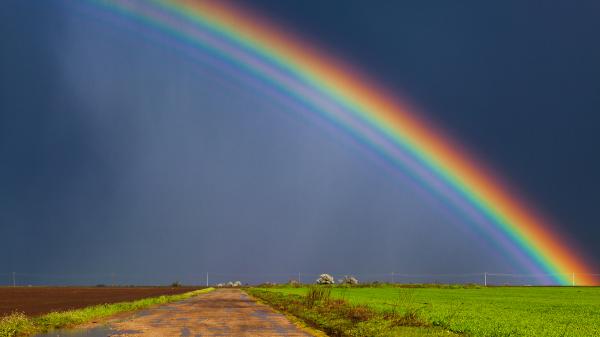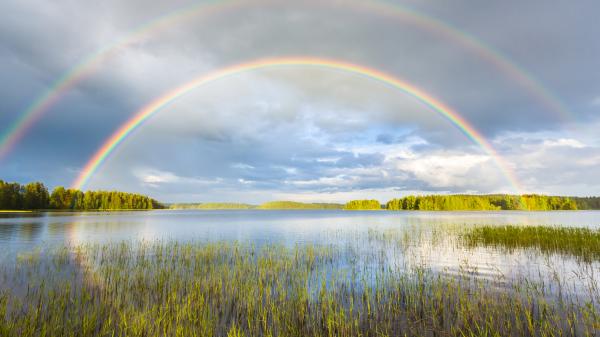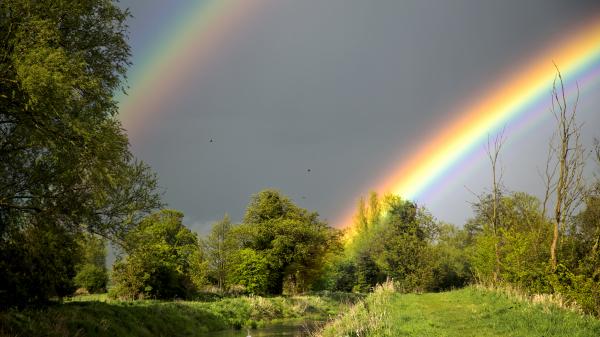What Is the Order of the Colors of the Rainbow
A rainbow is a multicolored arc in the sky which appears when sunlight hits water droplets. How does it get its colors? Why is it curved? And what is at the end of the rainbow?

Sun + rain = rainbow
©iStockphoto.com/constantinopris
Low Sun and Water Droplets
A rainbow can only form under the following conditions:
- The Sun must be above the horizon and not be obscured by clouds, mountains, or other obstacles.
- The Sun has to be quite low in the sky. If you are at the same elevation as your horizon, the Sun's altitude must be below 42° to create a rainbow that can be seen from your perspective. Solar altitude table
- The air opposite the Sun, as seen from your position, must be filled with a large number of water droplets.
Rainbows always appear in the sky opposite to the Sun. So, if you have your back to the Sun, the rainbow will arch across the sky in front of you.
Rainbows can also appear at night
How Do Rainbows Form?
A rainbow is an optical phenomenon which involves three processes: reflection, dispersion, and refraction.
Reflection
Water droplets can act like little mirrors. When a ray of sunlight strikes one of these tiny spheres of water, most of the light bounces off its rear wall and is reflected back. During a rain shower, the air is full of water droplets acting together like a reflective curtain made of millions of minuscule mirrors casting the sunlight back at you.
Dispersion

Reflection, dispersion, and refraction inside a water droplet.
But sunlight is white—so, if the water droplets reflect the sunlight, how does the rainbow gets its colors? This is where the second process comes into play: dispersion of light.
Pure sunlight may appear white to us, but it consists of all visible colors. As soon as a ray of sunlight enters a water droplet, it is split up into its components, causing its colors to fan out and become visible as a spectrum of colors. This happens both when the ray enters the droplet and when it leaves the droplet again.
Refraction
As the ray of light enters and leaves the water droplet, its direction is also changed slightly in a process called refraction. Each color is refracted in a marginally different direction, creating the impression of a fan of colors. For example, in relation to the direction of the incoming ray of light, the red light component leaves the droplet at a slightly larger angle than the orange component.
The Colors of the Rainbow
This means each water droplet reflects all of the colors of the sunlight back to you. However, because it reflects and refracts each color at a slightly different angle, only one color from each droplet reaches your eyes. For example, you can only see the red light from droplets that are higher in the sky, and only the orange light from the droplets that are a little lower.
This is how the top two stripes of the rainbow—red and orange—form. Further below, the droplets form an even sharper angle between you and the Sun, so they throw the yellow, green, blue, indigo, and violet components of the sunlight back at you, creating the remaining stripes of the rainbow.
Memorize the Color Sequence
If you are having trouble remembering the order of the rainbow colors, simply memorize the name Roy G. Biv. This imaginary first, middle, and last name is an acronym made up of the initial letter of each color, in the order they appear in a rainbow. From top to bottom, they are: red, orange, yellow, green, blue, indigo, and violet.
Why Is a Rainbow Curved?
Technically, a rainbow is the upper half of a circle of light, which centers on the antisolar point, the point directly opposite the Sun, as seen from your perspective. The lower half of the circle, however, is usually not visible since the water droplets hit the ground before it can form. You may be able to see a circular rainbow if you have a high vantage point and the terrain sharply drops off in the direction of the rainbow, allowing the rain to fall down farther and reflect the sunlight from a lower angle. It is also possible to see a circular rainbow from an airplane.
The shape of a rainbow is a result of the refractive index of water. This causes the sunlight to be reflected off rain droplets within a limited range of angles that lie between 0° and 42°. Most of the light is cast back at you in an angular range from 40° for violet light to 42° for red light. This is why the circle of light always has an angular distance of 40-42° from the antisolar point, meaning a rainbow always appears 40-42° away from the point opposite the Sun, as seen from your perspective.
What Is a Double Rainbow?

Double rainbow in Finland.
©iStockphoto.com/petejau
Sometimes you can see a fainter, second rainbow appear above a rainbow. This happens when sunlight is reflected twice inside each water droplet and directed back to you.
The second rainbow is not as bright as the primary rainbow, because some of the sunlight passes through the droplet, while most of it is reflected. This means more light goes astray when a ray of sunlight is reflected twice, leaving less light to be reflected back to you. The double reflection process also results in an inversion of the colors of the secondary rainbow. Here, the violet stripe is at the top while the red stripe appears at the bottom (click on the image to see this detail).
The angular distance between the second rainbow and the antisolar point is 50-53°, so the two rainbows are always about 10° apart.
Why Is the Area Below the Rainbow Brighter?
While most of the sunlight is concentrated at an angle of 40-42°, some of it is also reflected in the range of 0-39°. Crucially, the angle also determines the extent to which the sunlight is dispersed and refracted. For example, a ray of light that is reflected at 0°—right back where it came from—is not dispersed or refracted at all.
For this reason, we experience it as white light. The same is the case for light that is reflected at higher angles, although to a slightly lesser extent. This is why the area below the main rainbow looks comparatively bright, as shown in the images.
Alexander's Band

Alexander's band.
©iStockphoto.com/Pitmire
The physical properties of the water droplet prevent the sunlight from being reflected at angles above 42°. For example, it is impossible for a horizontal beam of light to be reflected at an angle of 90° and sent straight down toward the ground. While this maximum reflective angle is a little different for each wavelength (color), ranging from 40° for violet light to 42° for red light, none of the sunlight can be redirected at angles exceeding 42°.
Because of this, water droplets that are more than 42° away from the antisolar point, as seen from your perspective, will not reflect any sunlight back at you. This is why the sky above the primary rainbow looks a great deal darker than the sky below it (see image).
About 10° above the main rainbow, the doubly reflected sunlight of the second rainbow reaches your eyes, so the sky above that is a little brighter again, creating the impression of a dark band of sky sandwiched between the two rainbows. This phenomenon is called Alexander's band.
Is There a Pot of Gold at the End of the Rainbow?
According to an Irish legend, a pot of gold can be found at a rainbow's end. We probably all agree this is highly unlikely, but did you know it is possible to actually disprove that claim? In fact, you have probably been at the end of the rainbow many times without noticing!
To check the veracity of the pot-of-gold-legend, you need to go to the location where a rainbow touches the ground. This may seem like an impossible feat, given that a rainbow is, in a way, an optical illusion. As tangible and real a bright rainbow may appear, it is formed by countless small reflections of sunlight that are only visible from a certain perspective. This makes it impossible to actually approach a rainbow. If you move toward it, the rainbow will recede at an equal pace; a person who stands at the end of the rainbow you see will see a different, equally unapproachable rainbow farther back, if the weather conditions permit.
But in this realization also lies a chance to empirically disprove the Irish legend. If you can see another person at the end of your rainbow, you can stand at the end of another person's rainbow, or at least of a rainbow that is visible from a different perspective. So, you have probably been there, at the end of the rainbow, even if that particular rainbow was invisible to you at the time.
So. Did you find that pot of gold?
Topics: Atmospheric Phenomena, Sun
What Is the Order of the Colors of the Rainbow
Source: https://www.timeanddate.com/astronomy/rainbow.html